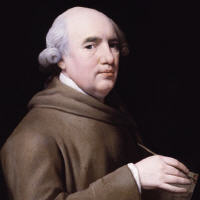
George Stubbs was classified in his lifetime as a sporting painter, and as such was excluded from full membership of the Royal Academy. He is best remembered for his paintings of horses and his conversation pieces. Having studied anatomy, Stubbs's pictures of horses are among the most accurate ever painted, but his work is lyrical and transcends naturalism.
Stubbs was born in Liverpool, the son of a leather worker, and he spent his early career in the north, painting portraits and developing his interest in anatomy. In the later 1740s he lived in York and supplied the illustrations for a treatise on midwifery. Following a brief visit to Rome in 1754 he settled in Lincolnshire, where he researched his major publication, 'The Anatomy of the Horse'. In about 1758 he moved to London, which remained his base.
Early clients for his sporting and racing paintings included many of the noblemen who founded the Jockey Club. Like Gainsborough, he later painted scenes of peasant life, as well as studies of wild and exotic animals. He also became known as a printmaker and for his paintings in enamel on Wedgwood earthenware plaques.